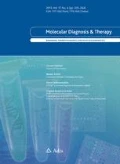Abstract
Array-based comparative genomic hybridization (array CGH) genome scanning is a powerful method for the global detection of gains and losses of genetic material in both congenital and neoplastic disorders. When used as a clinical diagnostic test, array CGH combines the whole genome perspective of traditional G-banded cytogenetics with the targeted identification of cryptic chromosomal abnormalities characteristic of fluorescence in situ hybridization (FISH). However, the presence of structural variants in the human genome can complicate analysis of patient samples, and array CGH does not provide morphologic information about chromosome structure, balanced translocations, or the actual chromosomal location of segmental duplications. Identification of such anomalies has significant diagnostic and prognostic implications for the patient. We therefore propose that array CGH should be used as a guide to the presence of genomic structural rearrangements in germline and tumor genomes that can then be further characterized by FISH or G-banding, depending on the clinical scenario. In this article, we share some of our experiences with diagnostic array CGH and discuss recent progress and challenges involved with the integration of array CGH into clinical laboratory medicine.


Similar content being viewed by others
References
Bejjani BA, Salek R, Baliff BC, et al. Use of targeted array-based CGH for the clinical diagnosis of chromosomal imbalances: is less more? Am J Med Genet 2005 Apr; 134(3): 259–67
Cheung SW, Shaw CA, Yu W, et al. Development and validation of a CGH microarray for clinical cytogenetic diagnosis. Genet Med 2005 Jul/Aug; 7(6): 422–32
Feuk L, Carson AR, Scherer SW. Structural variation in the human genome. Nat Rev Genet 2006 Feb; 7: 85–97
Smeets DFCM. Historical perspective of human cytogenetics: from microscope to microarray. Clin Biochem 2004 Jun; 37(6): 439–46
Pinkel D, Segraves R, Sudar D, et al. High resolution analysis of DNA copy number variation using comparative genomic hybridization to microarrays. Nat Genet 1998 Oct; 20(2): 207–11
Rauen KA, Albertson DG, Pinkel D, et al. Additional patient with del(12)(q21.2q22): further evidence for a candidate region for cardio-faciocutaneous syndrome? Am J Med Genet 2002 Jun 1; 110(1): 51–4
Gunn SR, Mohammed M, Reveles XT, et al. Molecular characterization of a patient with CNS dysmyelination and cryptic unbalanced translocation between chromosomes 4q and 18q. Am J Med Genet 2003 Jul 1; 120(1): 127–35
Moncla A, Missirian C, Phillip N, et al. Another patient with cryptic unbalanced translocation between chromosomes 4q and 18q: evidence by microarray CGH. Am J Med Genet 2004 Dec 15; 131(3): 314–7
Rowley JD. A new consistent chromosomal abnormality in chronic myelogenous leukemia identified by quinacrine fluoresence and Giemsa staining [letter]. Nature 1973 Jun 1; 243(5405): 290–3
Kearny L, Horsley SW. Molecular cytogenetics in haematological malignancy: current technology and future prospects. Chromosoma 2005 Sep; 114(4): 286–94
Shanafelt TD, Geyer SM, Kay NE. Prognosis at diagnosis: integrating molecular biologic insights into clinical practice for patients with CLL. Blood 2004 Feb 15; 103(4): 1202–109
Stankiewiccz P, Lupski JR. Genome architecture, rearrangements and genomic disorders. Trends Genet 2002 Feb; 18(2): 74–82
Nguyen D, Webber C, Ponting C. Bias of selection on human copy-number variants. PLoS Genet 2006 Feb; 2(2): 198–206
Acknowledgments
The authors wish to thank our colleagues at Combimatrix Molecular Diagnostics for their assistance with this manuscript, especially Dr Mercedes Gorre for providing critical review and Natasha Dzidic and Jaewon Kim for their invaluable contributions to the development of these arrays.
The hematological malignancies research was supported in part by the San Antonio Cancer Institute Cancer Center Support Grant (P30 CA54174) and an American Cancer Society (ACS) Institutional Research Grant.
Drs Gunn and Mohammed have a professional relationship with Combimatrix Molecular Diagnostics, with Dr Gunn serving as Medical Director, and Dr Mohammed serving as Chief Operating Officer.
Author information
Authors and Affiliations
Corresponding author
Rights and permissions
About this article
Cite this article
Gunn, S.R., Robetorye, R.S. & Mohammed, M.S. Comparative Genomic Hybridization Arrays in Clinical Pathology. Mol Diag Ther 11, 73–77 (2007). https://doi.org/10.1007/BF03256225
Published:
Issue Date:
DOI: https://doi.org/10.1007/BF03256225




